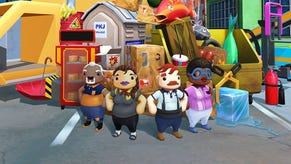Moss: Using VR to build a better mouse
Polyarc's Danny Bulla explains how the ex-Destiny developers settled on a concept for their PSVR debut about an adorable sword-wielding mouse
Two and a half years ago, Danny Bulla, Tam Armstrong, and Chris Alderson left their jobs at Bungie working on the studio's hit franchise Destiny in order to make their own games as Polyarc. Such a jump would be intimidating for any AAA developer going indie, but the trio upped the degree of uncertainty by choosing to build their new studio in the still-nascent market of virtual reality.
Polyarc's first project, Moss, was featured as part of Sony's Electronic Entertainment Expo media briefing earlier this month. A storybook adventure-puzzle game featuring an adorable sword-wielding mouse named Quill, Moss was one of just a handful of PlayStation VR titles afforded time during the briefing. While one might assume it was the kind of heartfelt personal project that would inspire a developer to go indie, Bulla told GamesIndustry.biz during the show that the VR part of things came first.
"VR seems to us like a blank canvas, and that's really what drove us," Bulla said. "We looked at the medium and said, 'We could build that.' Combined with the natural desire to share our own stories, we thought this would be a great opportunity for us to make an impression and create a world that we can share. And try to grab new players. I think a lot of people have been left behind with the complications that have arisen from where games are going. The cool thing about VR is that, while overwhelming, it allows us to reset back to simple, intuitive interfaces like reach-out-and-grab, which doesn't take as much explaining."
Bulla said the developers sat down to talk about what VR was and could be, used that as the basis for some core principles of the design, and then tried to find a game idea that would fit those. The two key ideas they settled on were comfort and immersion. In other words, they wanted to mitigate what is perhaps the tech's greatest potential pitfall in motion sickness and the like, and capitalize on its greatest strength, the ability to put players into the game in ways they've never experienced before.
"Because we chose comfort, we have you sitting down," Bulla said. "You don't have to move around, so we just have this space in front of you [to work with]. So we needed a hero that could fit within that space, that you could interact with, that could look you in the eye. And it all just started forming around that."
Of course, there's more to a comfortable VR experience than just sitting down, and like so many other VR developers, Polyarc had to learn about the rest of the details the hard way.
"We just embraced our constraints, and I think that's a way to approach a new medium."
"Before we landed on this small diorama dollhouse effect, we had some areas back when Quill was just a placeholder cube where we had her doing these long vista walks across a tree branch that was actually far away," Bulla said. "And we were iterating on that for a while and my eyes started to get a little sensitive to light at the end of the day. It turns out that having her so far away was causing my eyes to try to focus on basically infinity because it's on the screen. We quickly learned that we needed to make it intimate and bring it here (gestures in front of him)."
The team did a bit of research into what a comfortable distance for the human eye would be and started designing the game's playable areas around those parameters, making sure Quill never gets too far away from--or too close to--the camera. Because the game uses a storybook motif where each section of a level is confined to a page, they used that to standardize an interaction space, limiting how high or low Quill will be relative to the player's view, and what angles to the player she will enter the screen from on each new page.
The result is an interesting mix of direct control and indirect controls. For the most part, players use the controller to control Quill with an analog stick and face buttons as they would in any other sort of adventure game. But for actions where the player is interacting with the world, like turning the page of the game's storybook or moving blocks to help solve puzzles, they pull the triggers and move the DualShock 4 in real-world space in order to interact with the environment. There's also ample opportunity for particularly deft players to mix the two, using the analog stick to make Quill fight off multiple bugs while the indirect motion controls let the player reach out and "grab" some enemies to keep them from attacking.
"We kind of took the problem one piece at a time," Bulla said. "We looked at what would be good physical interaction, and we spent a lot of time iterating on that. Then we looked at back when games were new and people were just being introduced to controllers, what the controls for the more approachable of those games were, and that's how we landed on the simple input control scheme for Quill.
"And then for puzzles, we had to look at what makes a good puzzle. We've done a lot of action games, but none of us had any experience making a puzzle game. So we spent a lot of time looking at puzzle games we enjoy and are approachable, then tried to drill in on the nugget of what made those special. Then once we understood all of those things, we said not, 'How do we port it,' but 'What's the way to implement this in VR?' For us, that didn't just mean copying and pasting it. It meant understanding the core of the functionality and how is it best applied in a new medium."
He added, "We just embraced our constraints, and I think that's a way to approach a new medium. And I don't think you can do that until you've tried a lot of things, which we did. We've had plenty of failures in terms of our iterations. But what's come out of it is not ignoring the constraints and not trying to break past them; it's embracing them and creating the best thing we can within it."
"One of the reasons Moss is an approachable world is that we want people to be able to evangelize VR with it, show it to their children, their parents, their friends."
It's one thing to figure out how to build something in a new medium; it's another to figure out how to sell it. And Bulla said that just as developers are getting better at the former, so too are marketers coming to grips with the latter.
"It's really cool to watch both sides grow at the same time and learn the lessons," Bulla said. "I think one of the things that really stands out at E3 for VR is it's really hard to explain the experience you can have to someone, but once you put the headset on, it's very easy to talk about after the fact."
As a result, he sees touring shows and events that give people hands-on experiences with VR as the most powerful way to grow interest in the format. And while Polyarc and other developers are wholly reliant on their marketing partners to make those things happen, it's not entirely out of their control. For example, VR developers can deliberately make their games conducive to sharing.
"I remember going to my friend's house to play their Dreamcast, or showing people the Super Nintendo when it first came out," Bulla said. "One of the reasons Moss is an approachable world is that we want people to be able to evangelize VR with it, show it to their children, their parents, their friends. That's been a driving force in the decisions we made."
VR could certainly benefit from more shareable games. With the first year of high-end enthusiast VR in the books, there's no denying that the market hasn't lived up to some of the hype (with the acknowledgement that hype was probably unrealistic in the first place). And even though Polyarc is betting heavily on VR, Bulla isn't too concerned as yet.
"For us, we knew it was going to take time," he said. "We've never been in a position where we thought it was going to take off day one. We know how tech works. We saw how mobile worked. It took a few years before that took off. We knew it was going to take some time of people failing and learning lessons. And I think that's what we're starting to see now, developers who have taken time to really understand and figure out what it means to make a VR experience for a game."
And even if the worst-case scenario for VR comes to pass, Polyarc's developers have already shown themselves more than capable of traditional game development.
"It was important for us not to use VR in our name," Bulla said. "At our core, we're a game studio, and right now VR presents the best opportunity for us and is what we're excited about. But we're game developers. If we have a game that fits best on console or mobile or web, that's where we'll make it. But right now we're excited about VR and have a handful of ideas to fill the medium with."









